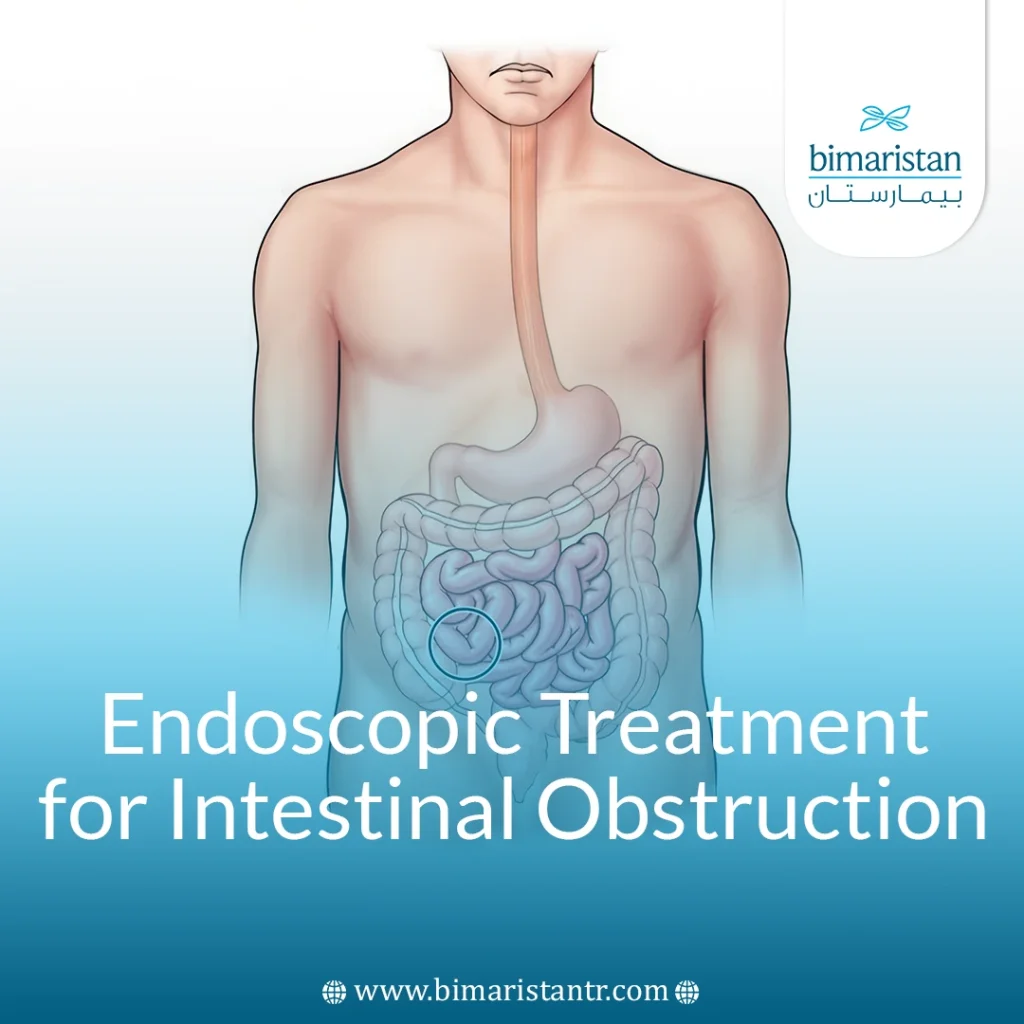Intestinal obstruction is a serious condition that can lead to fatal complications if not treated quickly, and with medical advances, endoscopic treatment for intestinal obstruction has become an effective and less invasive option than surgery. The success of treatment depends on early diagnosis and choosing the appropriate method for each case.
What is a bowel obstruction?
It is a disorder that occurs as a result of a mechanical or functional obstruction that prevents the passage of the contents of the digestive system through the small or large intestine, where the obstruction can be partial, in which the intestine allows the passage of some gases or feces, or complete, which prevents the passage of anything at all and is then considered an emergency, several reasons cause this condition, most notably: Adhesions after surgeries, hernias, intestinal coiling, and ingestion of foreign objects.
The blockage affects the normal bowel movement, causing food, gas, and waste to accumulate behind the blockage area, causing bloating, pain, digestive disorders, and, if not treated quickly, bowel rupture or abdominal infection.

Symptoms of bowel obstruction
- Severe abdominal pain, frequent colic, or flatulence, and inability to pass gas
- Persistent, bloody vomiting (in some advanced cases)
- Sudden or chronic constipation and possibly diarrhea (often with partial blockage)
- Loss of appetite and nausea
- Abdominal cramps or abdominal stiffness
- A feeling of fullness or pressure in the abdomen that results in loud, abnormal abdominal sounds
- Inability to have a bowel movement
- Rapid heartbeat (a sign of dehydration or shock)
- Dry mouth and little or no urination / dark-colored urine
- A general feeling of fatigue or tiredness (Malaise)
- High temperature (if there is inflammation or complications)
- Bad breath odor
- Symptoms of trauma (in advanced and serious cases)
- In children: Constant crying, pulling legs into the abdomen, lethargy, green or yellow vomiting, or blood in the stool
Diagnosis of bowel obstruction
Diagnosis of bowel obstruction typically begins promptly, as it is a medical emergency. Diagnosis includes the following:
- Clinical examination and history taking: The doctor palpates the abdomen for swelling or lumps and listens to bowel sounds with a stethoscope. He or she also asks about previous surgeries and current symptoms such as pain, vomiting, or constipation to evaluate the possibility of endoscopic treatment for intestinal obstruction.
- X-rays of the abdomen: Used to detect a blockage, it may show gas buildup or signs of intestinal rupture, guiding the decision toward endoscopic treatment for intestinal obstruction.
- CT Scan: Provides detailed images of the intestines and helps determine the location and cause of the blockage, such as tumors, twists, or adhesions, which may be managed through endoscopic treatment for intestinal obstruction.
- Diagnostic endoscopy: Used in some cases to see the inside of the bowel, especially if the cause is unclear or to confirm the diagnosis before proceeding with endoscopic treatment for intestinal obstruction.
- Blood tests: These are done to check for signs of inflammation, such as an elevated white blood cell count, and to assess the patient for dehydration or electrolyte imbalances, which are essential before considering endoscopic treatment for intestinal obstruction.
When is endoscopy used to treat bowel obstruction?
Endoscopic treatment for intestinal obstruction is used in cases where the blockage is:
- Partial rather than complete, allowing some air or liquid to pass through.
- Caused by an internal hernia or a foreign body that can be managed endoscopically.
- Due to small tumors or short (less than 4 cm) accessible narrowings.
- The result of infections or post-surgical strictures (conduction strictures), where balloon therapy can be effective as part of endoscopic treatment for intestinal obstruction.
- Related to some benign conditions, such as Crohn’s disease or ulcerative colitis, provided the disease is not highly active.
Endoscopic treatment for intestinal obstruction steps
Preparations before endoscopic treatment for intestinal obstruction.
- Fasting from food and drink 8 hours before the operation, but in some cases, the operation may be an emergency, and the person cannot fast.
- Inform the doctor of all medications, supplements, and vitamins you are taking before the procedure.
- Quit smoking as soon as possible, as smoking can affect the results of the operation and delay recovery.
Endoscopic treatment for intestinal obstruction: procedure steps
Endoscopic treatment for intestinal obstruction takes only about 30 minutes, and in some severe cases it may take longer. The steps of the procedure include the following:
- The patient is placed under general anesthesia.
- The doctor makes several small incisions near the blockage causing the issue.
- Carbon dioxide gas is introduced through openings to inflate the abdomen, allowing the doctor to better see the organs that need to be corrected.
- An endoscope is inserted through one of the incisions, through which the doctor checks the location and extent of the damage caused by the bowel obstruction.
- The doctor inserts surgical instruments through the other incisions to treat the issue.
- Finally, the incisions are closed with stitches.
What to expect after endoscopic treatment for intestinal obstruction
The following is expected after the procedure:
- Most patients need to be hospitalized for five to seven days after bowel obstruction surgery.
- Before the patient is discharged, they are checked to make sure they are able to pass gas naturally before they are allowed to drink small amounts of fluids.
- The doctor usually recommends starting with clear liquids and then gradually moving on to soft foods.
- It may take several weeks or months for the patient to return to full activity.
Endoscopic treatment for intestinal obstruction features
- Less invasive than traditional surgery: This is the primary feature that differentiates endoscopy from open surgery.
- Low risk of complications such as infection or adhesions: Complications after surgery are a major cause for concern, and this is a critical factor.
- Less pain after the procedure: Helps reduce the need for painkillers and improves patient comfort.
- Shorter hospital stays: A direct indicator of faster recovery and lower costs.
- Faster recovery and a quicker return to normal activity: It has a direct impact on the patient’s quality of life after treatment.
- Low risk of visible or internal scarring: Aesthetically and functionally important to patients, especially in the long term.
- Effective clinical outcomes in appropriate cases: Summarize the efficacy provided the appropriate clinical situation is selected.
Possible risks and complications of endoscopic treatment for intestinal obstruction
The procedure is considered safe, but some temporary or rare side effects may occur, including:
- Bleeding or infection, and possible damage to nearby organs
- Perforation of the intestine, which can cause what is known as anastomotic leakage, which is a serious condition that requires immediate medical attention
- Temporary paralysis of the intestines, called paralytic ileus
- Forming a blood clot
- Failure of the procedure and having to switch to open surgery
- Recurrence of blockage if the root cause is not addressed
In conclusion, endoscopic treatment for intestinal obstruction is a modern and effective option in dealing with selected cases, providing a less invasive alternative to surgery and contributing to faster recovery and fewer complications. The application of endoscopic treatment for intestinal obstruction requires careful evaluation by a specialized medical team to determine the appropriateness of each case based on the location of the obstruction, its cause, and the patient’s overall health status. While this treatment option is important, early diagnosis and prompt intervention are crucial to the success of endoscopic treatment for intestinal obstruction and avoiding the development of complications or complex surgical interventions.
Sources:
- Healthdirect Australia. (2024, September). Bowel obstruction in adults – causes and symptoms. Retrieved June 27, 2025,
- National Library of Medicine. (2024, May 14). Intestinal obstruction and ileus. MedlinePlus.

